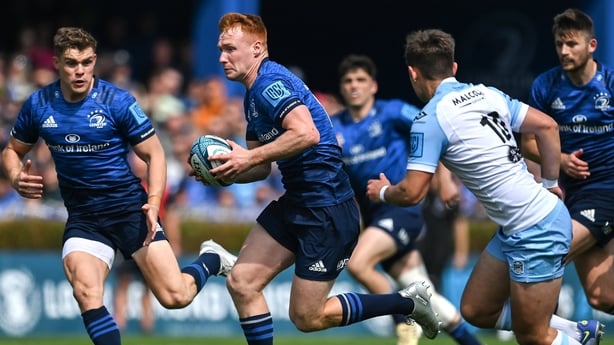Leinster will grab the headlines because of their absolute thrashing of Glasgow, but Ulster deserve a lot of credit too for the way they dismantled Munster at the Kingspan stadium on Friday evening.
Both teams played fantastic, free-flowing rugby which will be hugely promising for Andy Farrell when he sits down to pick his squad for the New Zealand tour.
Comparisons can be drawn from the tries on show in both games. For Stewart Moore's first try against Munster, Ulster played through the hands of Stuart McCloskey in the number 12 jersey, and he pulled a pass out behind his forward runner to James Hume, who then tipped a fast pass on to Robert Balacoune, who accelerated into the gap between Chris Farrell and Andrew Conway.
Ulster were able to throw six passes before Munster put any contact on them. Alex Kendellan finally got to Ethan McIlroy before his offload became the seventh pass en route to a glorious try for Stewart Moore.
Leinster scored an unbelievable try from a kick receipt which also contained seven passes before Garry Ringrose took contact when crossing the try line. It started with a typical pull back pass from the middleman in a trio of Leinster forwards, Ross Byrne and Ringrose had touches before O’ Brien’s fast pass gave Frawley the space to find a longer pass to Jordan Larmour. Larmour did most of the damage on the wing before finding an inside pass to Ringrose for the try.
O'Brien and Hume both threw the all-important fast pass at the gain line which unlocked the defences on these occasions. Both players should find their way on to the plane to New Zealand. Even if it wasn’t an extended squad travelling due to the midweek games, both players have been in phenomenal form and have to be in Andy Farrell’s plans.
Hume was at the centre of everything that Ulster created. Their set-piece plays were executed brilliantly, and he was the one that either ran an excellent line or gave the decisive pass on a number of occasions, including a clever tap and pass to Cooney for the opening try of the match.
Leinster and Ulster both had wingers running soft arcing lines off the distributors shoulder which put them in to pockets of space between defenders. When wingers are active like this, they can find space between defenders, like Balacoune did, or they can turn the opposition hips inwards which creates the space on the outside, which is what Leinster did repeatedly.
Munster and Glasgow didn’t cover themselves in glory defensively. Modern defences are much more confrontational and get up in the faces of the attacking players. This means that the defence will be looking to make reads and decisions higher up the pitch to stop the attack early on. This usually means that the defence won’t be happy if the attack are able to throw the third pass. The aim is always to shut down the attack before this or to hit man and ball on the third pass.
In the above examples, both teams got at least six passes away without being met with any contact. It shows that the defence was scrambling and not able to keep up, but it also shows the complexity in both attacking structures. They must have multiple options running at the defensive line if the defence isn’t able to shut them down in two to three passes. Defenders either have to sit down and be less aggressive due to the number of options and decisions presented to them, or they risk making a read on the wrong player and leaving gaps like the ones that Hume and Balacoune ran into.

For Leinster, Ciaran Frawley was pivotal with his playmaking abilities in the number 12 jersey. We saw La Rochelle playing a lot more than Leinster off their midfielders and Leinster seemed to use Frawley in a similar role at the weekend.
Ireland play with a very similar attacking style to Leinster so their dominance in the game at the weekend, and for the majority of the season, will be hugely beneficial for Ireland.
The fact that Ulster had such a positive performance with high quality attacking play is also good news for Andy Farrell and will give him more options when selecting a team to take on the All Blacks.
Balacoune has to become a real option for Farrell now. He’s a deceptively strong runner and is a top-class finisher when the distribution from players around him is accurate. If you put Balacoune into some of the positions that Ireland have put Mack Hansen and James Lowe into, he’ll undoubtedly pop up with international tries.
Hume can’t do anymore to force Andy Farrell into making a decision in the midfield. He has taken the pressure of McCloskey in the Ulster midfield and is very strong in both attack and defence.
Unfortunately, he is up against Gary Ringrose for the number 13 jersey. Ringrose had another very strong performance for Leinster at the weekend and is very calm when making very aggressive defensive decisions as well as having deft touches in attack.
Farrell has to find a way to get the likes of Hume, Balacoune, O'Brien and Frawley into Test matches. The return of midweek matches on this summer tour to New Zealand will undoubtedly help, but you’d think at this stage that those guys won’t be happy with a midweek jersey.
Both Ulster and Leinster now face South African opponents in the semi-final stage of the URC. This is what tournament organisers would have been hoping for, and Leinster have been asking for a bigger challenge in the league over the last number of seasons.
There are two big semi-finals to come before Andy Farrell can start finalising his squad for the summer tour. Both Leinster and Ulster will be looking to build on their performances and bring consistency to the attacking flair on show last weekend.


